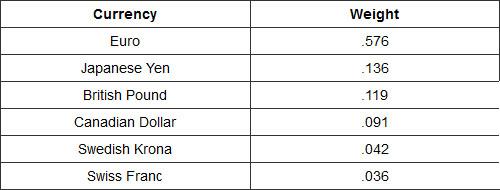Have you watched the US Dollar Index (USDX) Futures contract trade during the day? Do you notice that with each price change the intervals are always a minimum tick of .005? And then at the end of the day when you look at your daily candle of the USDX you see a closing price like 97.197. I want to shed some light on this topic of how the Intercontinental Exchange (ICE) settles the USDX each day.
Free WorkshopWith each Futures contract traded on any Futures Exchange, they each have their own unique contract specifications. One of the standardized specifications is something called a minimum tick increment. Unlike a Stock, all Futures contracts trade at their minimum tick increments as the smallest possible price change. No trading is allowed between the bid/ask price. This will make the bid/ask spread at a minimum .005 wide at any point during the trading session.
When the ICE settles the USDX daily they use a different minimum tick for the settlement time of .001 instead of the usual .005. This is why you see your daily candles with closes like 97.197 instead of 97.195 as one would expect with a minimum tick of .005.
But why do they do this?
First let’s describe what the USDX is. Simply put, the USDX is a weighted basket of six currency markets. The table shows the six currency markets and the individual weight they carry in the USDX.
The USDX is a physically deliverable Futures contract meaning a trader must be aware of First Notice and Last Trading days of the contract. Each point in the USDX is worth US $1,000.00. The minimum tick interval of .005 is worth US $5.00. To trade one USDX Futures contract overnight would currently require an initial margin (collateral given to broker to cover any losses while in the trade) of US $2,145 as of the recent increase March 26, 2015.
To find out the value of the USDX you simply take the last price on your screen and multiply it by the point value. For example, 97.135 X US$1,000 = US$97,135
Using leverage in the Futures markets allows you to control this US$97,135 contract for only US$2,145 per contract.
During the trading session the USDX can be rounded to the nearest .005 with each tick. Between 14:59 ET & 15:00 ET Monday – Friday the USDX has a closing range established during the last 1 minute before 15:00 ET. During this time a volume weighted average price (VWAP) is created. For each tick increment traded during this closing range the price that traded the most volume during this one minute period becomes the settlement price for the day.
Since this is a weighted basket of currencies each currency will have its individual settlement price from its respective Exchange it trades on. This settlement price is then multiplied by the percentage of weight it carries in the USDX. Then all six currencies are averaged into the USDX and in this averaging the ICE Exchange uses the .001 tick increment to get as close to the actual value of the weighted currencies in the USDX basket.
For this reason you will usually see your net change on the USDX each day looking like +/- .172 (or some value thereof coming off the previous settlement using .001) and not the usual +/- .015 (where each tick is .005).
I would invite you to visit the ICE Exchange and read more about the contract specifications for the USDX and become familiar with some of the different specifications you may not find in other popularly traded Futures markets.
“There are two ways of being rich. One is to have all you want, the other is to be satisfied with what you have”
This content is intended to provide educational information only. This information should not be construed as individual or customized legal, tax, financial or investment services. As each individual's situation is unique, a qualified professional should be consulted before making legal, tax, financial and investment decisions. The educational information provided in this article does not comprise any course or a part of any course that may be used as an educational credit for any certification purpose and will not prepare any User to be accredited for any licenses in any industry and will not prepare any User to get a job. Reproduced by permission from OTAcademy.com click here for Terms of Use: https://www.otacademy.com/about/terms
Editors’ Picks

EUR/USD rebounds after falling toward 1.1700
EUR/USD gains traction and trades above 1.1730 in the American session, looking to end the week virtually unchanged. The bullish opening in Wall Street makes it difficult for the US Dollar to preserve its recovery momentum and helps the pair rebound heading into the weekend.

USD/JPY rallies to near 157.00 as Yen plunges after BoJ’s policy outcome
The USD/JPY is up 0.85% to near 156.90 during the European trading session. The pair surges as the Japanese Yen underperforms across the board, following the Bank of Japan monetary policy announcement. In the policy meeting, the BoJ raised interest rates by 25 bps to 0.75%, as expected, the highest level seen in three decades.

Gold stays below $4,350, looks to post small weekly gains
Gold struggles to gather recovery momentum and stays below $4,350 in the second half of the day on Friday, as the benchmark 10-year US Treasury bond yield edges higher. Nevertheless, the precious metal remains on track to end the week with modest gains as markets gear up for the holiday season.

Crypto Today: Bitcoin, Ethereum, XRP rebound amid bearish market conditions
Bitcoin (BTC) is edging higher, trading above $88,000 at the time of writing on Monday. Altcoins, including Ethereum (ETH) and Ripple (XRP), are following in BTC’s footsteps, experiencing relief rebounds following a volatile week.

How much can one month of soft inflation change the Fed’s mind?
One month of softer inflation data is rarely enough to shift Federal Reserve policy on its own, but in a market highly sensitive to every data point, even a single reading can reshape expectations. November’s inflation report offered a welcome sign of cooling price pressures.
RECOMMENDED LESSONS
Making money in forex is easy if you know how the bankers trade!
I’m often mystified in my educational forex articles why so many traders struggle to make consistent money out of forex trading. The answer has more to do with what they don’t know than what they do know. After working in investment banks for 20 years many of which were as a Chief trader its second knowledge how to extract cash out of the market.
5 Forex News Events You Need To Know
In the fast moving world of currency markets where huge moves can seemingly come from nowhere, it is extremely important for new traders to learn about the various economic indicators and forex news events and releases that shape the markets. Indeed, quickly getting a handle on which data to look out for, what it means, and how to trade it can see new traders quickly become far more profitable and sets up the road to long term success.
Top 10 Chart Patterns Every Trader Should Know
Chart patterns are one of the most effective trading tools for a trader. They are pure price-action, and form on the basis of underlying buying and selling pressure. Chart patterns have a proven track-record, and traders use them to identify continuation or reversal signals, to open positions and identify price targets.
7 Ways to Avoid Forex Scams
The forex industry is recently seeing more and more scams. Here are 7 ways to avoid losing your money in such scams: Forex scams are becoming frequent. Michael Greenberg reports on luxurious expenses, including a submarine bought from the money taken from forex traders. Here’s another report of a forex fraud. So, how can we avoid falling in such forex scams?
What Are the 10 Fatal Mistakes Traders Make
Trading is exciting. Trading is hard. Trading is extremely hard. Some say that it takes more than 10,000 hours to master. Others believe that trading is the way to quick riches. They might be both wrong. What is important to know that no matter how experienced you are, mistakes will be part of the trading process.
The challenge: Timing the market and trader psychology
Successful trading often comes down to timing – entering and exiting trades at the right moments. Yet timing the market is notoriously difficult, largely because human psychology can derail even the best plans. Two powerful emotions in particular – fear and greed – tend to drive trading decisions off course.

